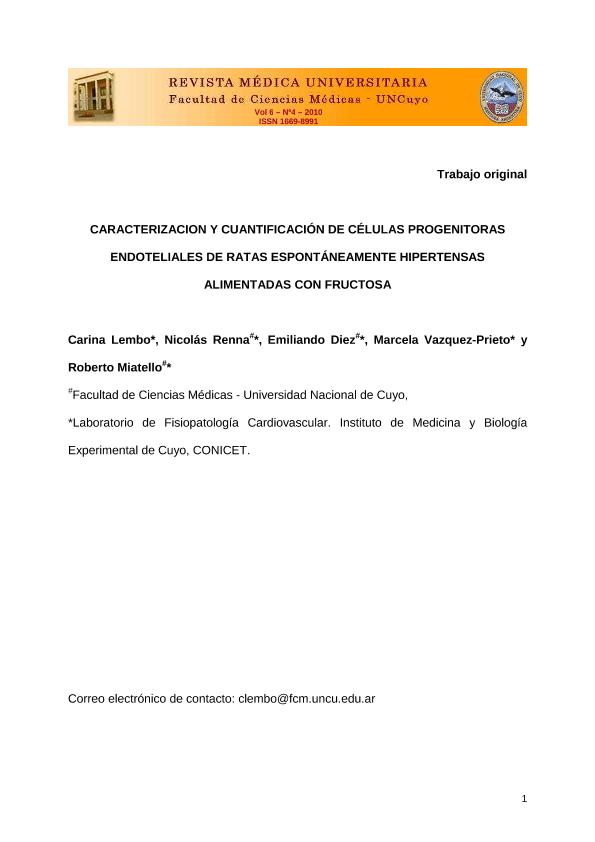Artículo
Objective: To examine alterations in participation of endothelial progenitor cells (EPC) because of insulin resistance (IR) associated with an experimental model of metabolic syndrome (MS) generated by chronic administration of fructose to spontaneously hypertensive rats (SHR) Material and methods: WKY and SHR rats, male, were distributed into 4 groups (n = 8 c/u): WKY: control; FFR: WKY receiving fructose in drinking water to 10% (v/v) for 6 weeks , SHR; FFHR: SHR receiving fructose in drinking water to 10% (v/v) for 6 weeks. At the end of the protocol the following variables were determined: systolic blood pressure, biochemical variables, HOMA index, levels of EPC quantified by flow cytometry in peripheral blood and bone marrow, immunofluorescence in cell culture to identify markers CD34 and VEGFR-2, EPC colony count and NAD(P)H-oxidase activity in aortic tissue. Results: We confirmed the experimental model based on metabolic variables analyzed. A decrease in the levels of CPE, in peripheral blood and bone marrow, which becomes more important groups of animals treated with fructose was observed .In these groups there are also fewer colonies of developed EPC in cell culture and exhibit an increased levels of oxidative stress, estimated by the activity of NAD(P)H-oxidase. Conclusion: the SM caused by chronic administration of fructose in FFHR has proven to generate a decrease in the levels of CPE, as well as its functional capacity. The intracellular mechanisms that produce this phenomenon could be triggered by the degree of IR presented in this experimental model. Objective: To examine alterations in participation of endothelial progenitor cells (EPC) because of insulin resistance (IR) associated with an experimental model of metabolic syndrome (MS) generated by chronic administration of fructose to spontaneously hypertensive rats (SHR) Material and methods: WKY and SHR rats, male, were distributed into 4 groups (n = 8 c/u): WKY: control; FFR: WKY receiving fructose in drinking water to 10% (v/v) for 6 weeks , SHR; FFHR: SHR receiving fructose in drinking water to 10% (v/v) for 6 weeks. At the end of the protocol the following variables were determined: systolic blood pressure, biochemical variables, HOMA index, levels of EPC quantified by flow cytometry in peripheral blood and bone marrow, immunofluorescence in cell culture to identify markers CD34 and VEGFR-2, EPC colony count and NAD(P)H-oxidase activity in aortic tissue. Results: We confirmed the experimental model based on metabolic variables analyzed. A decrease in the levels of CPE, in peripheral blood and bone marrow, which becomes more important groups of animals treated with fructose was observed .In these groups there are also fewer colonies of developed EPC in cell culture and exhibit an increased levels of oxidative stress, estimated by the activity of NAD(P)H-oxidase. Conclusion: the SM caused by chronic administration of fructose in FFHR has proven to generate a decrease in the levels of CPE, as well as its functional capacity. The intracellular mechanisms that produce this phenomenon could be triggered by the degree of IR presented in this experimental model.
Caracterización y cuantificación de células progenitoras endoteliales de ratas espontáneamente hipertensas alimentadas con fructosa
Lembo, Carina ; Renna, Nicolas Federico
; Renna, Nicolas Federico ; Diez, Emiliano Raúl
; Diez, Emiliano Raúl ; Vázquez Prieto, Marcela; Miatello, Roberto Miguel
; Vázquez Prieto, Marcela; Miatello, Roberto Miguel
 ; Renna, Nicolas Federico
; Renna, Nicolas Federico ; Diez, Emiliano Raúl
; Diez, Emiliano Raúl ; Vázquez Prieto, Marcela; Miatello, Roberto Miguel
; Vázquez Prieto, Marcela; Miatello, Roberto Miguel
Fecha de publicación:
12/2010
Editorial:
Universidad Nacional de Cuyo. Facultad de Ciencias Médicas
Revista:
Revista Médica Universitaria
ISSN:
1669-8991
Idioma:
Español
Tipo de recurso:
Artículo publicado
Clasificación temática:
Resumen
Archivos asociados
Licencia
Identificadores
Colecciones
Articulos(IMBECU)
Articulos de INST. DE MEDICINA Y BIO. EXP. DE CUYO
Articulos de INST. DE MEDICINA Y BIO. EXP. DE CUYO
Citación
Lembo, Carina; Renna, Nicolas Federico; Diez, Emiliano Raúl; Vázquez Prieto, Marcela; Miatello, Roberto Miguel; Caracterización y cuantificación de células progenitoras endoteliales de ratas espontáneamente hipertensas alimentadas con fructosa; Universidad Nacional de Cuyo. Facultad de Ciencias Médicas; Revista Médica Universitaria; 6; 4; 12-2010; 1-18
Compartir



